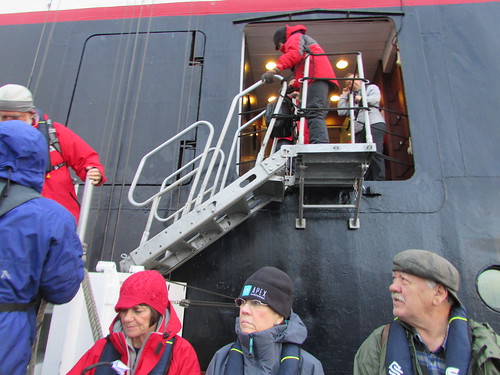In the previous post in this series Sailing to the Falkland Islands our ship was sailing to the Falkland Islands. Our first landings in the Falklands proved tiring but exhilarating ...
We arrived at Steeple Jason Island around 6.0 a.m. This is one of of the Jasons, a group of small islands to the north west of the main Falkland Islands, West and East Falkland. I took breakfast in my cabin at six so as to be ready for disembarkation by Zodiac a little after seven. Steeple Jason is around four miles long and half a mile wide, lying roughly north-west to south-east, saddle shaped with raised ground at each end (the taller rising to about 1,000 feet above the sea) and a low isthmus in the centre where we made our landing.
 Passengers leaving the ship at Steeple Jason Island for the first landing of the trip.
Passengers leaving the ship at Steeple Jason Island for the first landing of the trip.
The sea was calm, there was little wind but our landing was made on to a very rocky shore where the landing party had laid a succession of towels and carpets along a cleft in the rocks to allow us to reach the sparse grassland beyond. Informally divided into various groups, each with a naturalist as guide, we started our walk and soon came to the extensive colonies of young penguins who seemed quite untroubled by the line of people walking by. There were various bird species, particularly the Striated Caracara, who just stood and watched or patrolled the area on the ground, looking for food, equally untroubled by our presence. We continued our walk on rising ground in order to reach the rookery of the Black-browed Albatross, where we expected to see over 1,000 young birds.
 Gentoo penguins on Steeple Jasob Island.
Gentoo penguins on Steeple Jasob Island.
To get close to the rookery, we had to descend, in single file, through luxuriant Tussock Grass which extendied to head height. Our group then stood or sat around periphery of the nursery of young birds. Each breeding pair produces one egg a year which is placed in a dished recess topping a short nesting pedestal and incubated, in turn, by both parents. Once hatched, the chick waits on the nest for a parent to arrive with food. Both parents hunt for food and, on returning to the nest, the parent will feed only its own chick, by a combination of visual recognition and audible signals. We spent a magical hour just watching the mesmerising scene or taking pictures. Jonathan Roussouw was on hand to provide detailed explanations of the life of these birds.
 A Black-browded Albatross chick.
A Black-browded Albatross chick.
Eventually, Johnathan indicated that it was time to walk back to our landing point and return to the ship by Zodiac. With a certain reluctance, we complied and, over lunch on board, exchanged our morning’s experiences with the other passengers.
Related posts
Next South Atlantic post.
All my posts on this trip can be found here.
My pictures
You can find all my pictures on the trip in the Collection Cape to Cape (still being added to, at the time of writing).
There are a few pictures of the trip in the album South Atlantic Voyage.
['Cape to Cape' collection added 5-Apr-2016]
